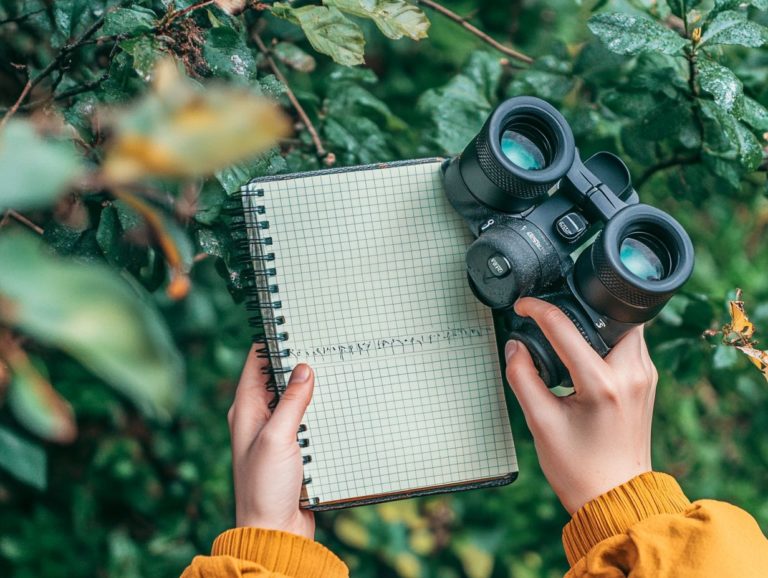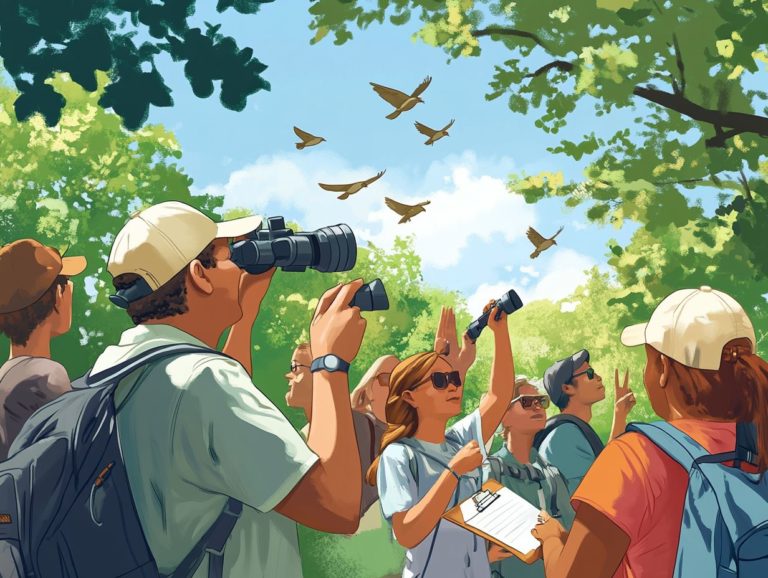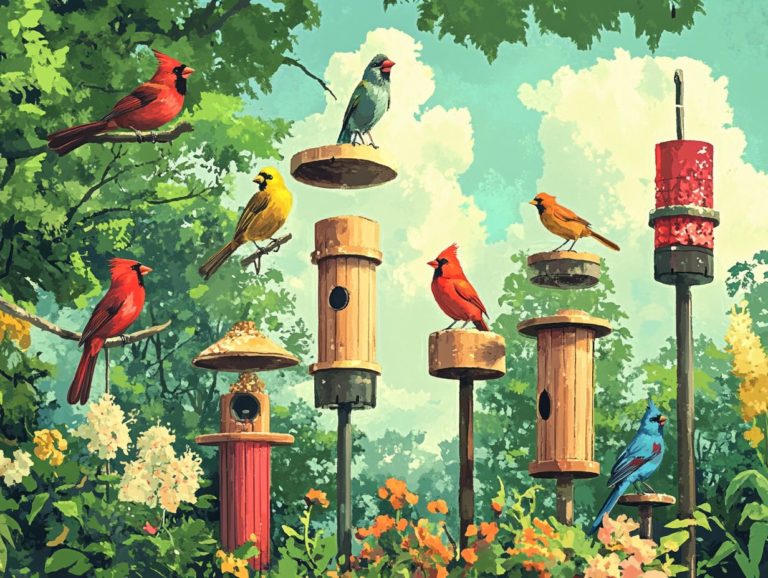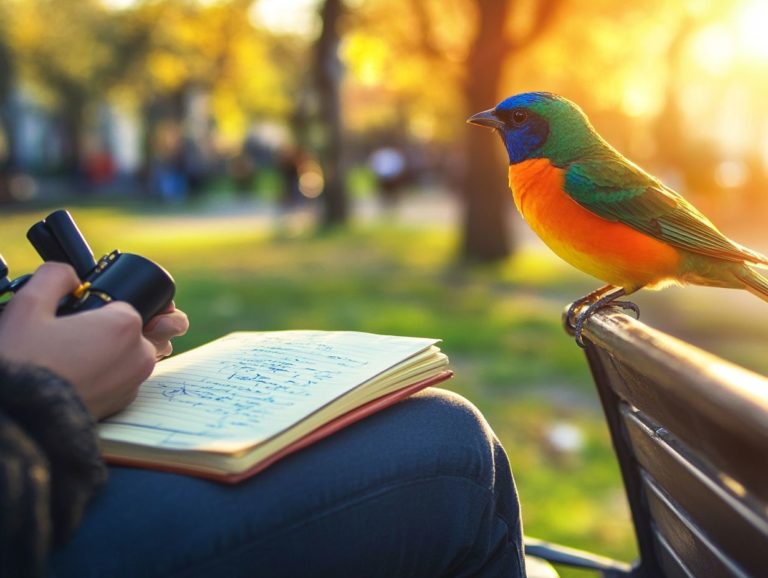What Are the Best Practices for Bird Watching with Kids?
Bird watching is a fantastic way for kids to connect with nature, sparking curiosity and a love for the outdoors. This article explores how bird watching benefits children by enhancing their observation skills and teaching them patience.
It also offers tips on preparing for a birding outing with children, suggesting the best locations and necessary gear. You’ll also discover fun activity ideas to keep kids engaged, plus tips for ensuring their safety and promoting respect for nature.
Contents
- Key Takeaways:
- The Benefits of Bird Watching for Kids
- Preparing for a Bird Watching Trip with Kids
- Engaging Kids During Bird Watching
- Safety Tips for Bird Watching with Kids
- Protecting Against Injuries and Hazards
- Respecting Wildlife and Their Habitat
- Frequently Asked Questions
- What are the best practices for bird watching with kids?
- How do I choose a suitable location for bird watching with kids?
- What gear should I bring for bird watching with kids?
- How do I teach kids about safety during bird watching?
- What is the importance of teaching kids about respect for nature during bird watching?
- Are there any other tips for bird watching with kids?
Key Takeaways:
- Introduce kids to the wonders of nature through bird watching and help them develop a lifelong love for the environment!
- Encourage them to become better observers and teach them patience while exploring the great outdoors.
- Make bird watching trips fun by incorporating activities and involving them in identifying and recording birds.
The Benefits of Bird Watching for Kids
Bird watching, or birding, offers many benefits for children. It fosters a love for nature, instills environmental awareness, and enhances observational skills.
Through birding, children can explore their surroundings, identify species like the red-winged blackbird and American robin, and appreciate the diverse environments that support backyard birds.
Community programs like the Great Backyard Bird Count help children feel a sense of community in nature and a responsibility toward it. These initiatives teach them about conservation while encouraging quality outdoor time with family and friends.
Developing a Love for Nature
Bird watching helps children feel amazed by exposing them to the songs and behaviors of various bird species in their natural environments. As they watch these birds in their bird-friendly backyards, they cultivate curiosity about the world around them.
This exploration goes beyond identifying birds; it also involves discovering their habitats and understanding what resources they need to thrive. By creating bird-friendly backyards, families can foster a vibrant space for wildlife and enhance their appreciation for the delicate balance of nature.
Recognizing habitat boundaries helps children connect with the ecosystem, showing them how different components interact. This enriches their overall learning experience.
Improving Observation and Patience Skills
Bird watching helps kids become better observers and teaches them patience. They learn to use binoculars to spot and identify various bird species.
By focusing through the lenses, they develop a keen eye for noticing colors, behaviors, and other details that might go unnoticed.
Keeping a field journal allows them to record their observations and promotes reflective thinking. This fosters a deeper connection with nature.
Additionally, birding apps offer informative content that makes learning enjoyable and interactive. Through these diverse approaches, children embark on a rewarding journey of bird identification that instills patience and careful observation while helping them appreciate the beauty and intricacies of the world around them.
Preparing for a Bird Watching Trip with Kids
Bird watching with children is most enjoyable when it is well-planned and equipped with the necessary gear, like field guides and binoculars.
This preparation enhances the experience of observing birds in various habitats, including urban areas and locations with bird feeders.
In conclusion, bird watching is a rewarding activity that can connect kids to nature, boost their skills, and create lasting memories. Engage your children in this wonderful experience today!
Choosing the Right Location
The best places for bird watching are bird hot spots like parks and wetlands. These locations increase the chances of seeing many different types of birds during events like the Great Backyard Bird Count.
Visit the Washington coast to see migratory birds on sandy shores. The rainforests of British Columbia, Canada, are also great for spotting diverse flocks year-round.
Utilizing local birding guides, online forums, and state wildlife agency websites can help you find the best times to visit. Early mornings during spring migrations are usually the ideal times, as this is when the largest and most diverse flocks are on the move.
Planning trips around these times and locations can enhance your bird-watching experience and make this enjoyable pastime even better.
Essential Equipment and Supplies
Essential equipment for bird watching includes high-quality binoculars, a field guide to help you identify birds, and a bird feeder to attract backyard species. These tools can make your bird-watching experience even more immersive.
Binoculars are crucial for bird watching. They help you see distant birds clearly. A field guide is also important, as it is useful for both novice and experienced birders. It typically contains pictures of many species along with information about their behavior, habitats, and calls.
Many bird watchers now use field guides available as mobile apps, like the Sibley Field Guide and Merlin Bird ID. Bird feeders can significantly enhance your backyard bird-watching by attracting a variety of species.
Bird-watching apps provide valuable help for identifying birds by using your phone’s GPS function to record the time and location of the birds you see. These apps foster a community aspect, allowing you to log, track, and compare your sightings with other bird watchers.
Engaging Kids During Bird Watching
The most effective way to keep children engaged during bird watching is to incorporate fun activities. These activities can help them identify birds while expanding their knowledge of environmental awareness and conservation efforts.
Fun Activities and Games
Engaging activities related to bird watching can boost children’s knowledge about birds, including identifying bird songs. For example, games that involve guessing bird songs or competing to identify the most species can be both entertaining and educational.
Outdoor games spark children’s curiosity about nature and make learning fun. Families can enjoy a scavenger hunt designed to find various birds, checking them off a list as they spot them.
Organizing a ‘bird call’ imitation competition allows children to mimic different bird sounds. These activities help them develop listening skills and creativity while fostering family bonding and a love for the outdoors.
Involving Kids in Identification and Recording
Engaging children in bird identification and encouraging them to record their observations in a field journal or through platforms like eBird enhances their learning. By observing various bird species, children can appreciate the intricate interrelationships within avian ecosystems.
They learn to identify different bird species while gaining insight into their habitats, feeding behaviors, and migratory patterns. Tools like eBird enable them to document their observations and share findings with a community of citizen scientists.
This involvement deepens their understanding and allows them to contribute to conservation efforts. It shows how even small individual actions can play a significant role in the global effort to protect biodiversity.
Safety Tips for Bird Watching with Kids
Ensuring safety while bird watching with children is crucial. This includes taking precautions against potential injuries and hazards, as well as instilling respect for wildlife and their habitats.
Protecting Against Injuries and Hazards
The best way to prevent injuries while bird watching is to ensure outdoor safety. Always supervise children and have a basic first aid kit on hand.
Children are especially vulnerable to uneven ground, slippery surfaces, and approaching wildlife. It’s crucial to prepare them for outdoor bird watching by discussing the dangers they might encounter.
To help keep children safe on a bird watching trip, consider these strategies:
- Ensure they stay close to an adult and follow instructions.
- Provide sturdy shoes for navigating rough terrain.
- Teach them to observe birds from a safe distance.
Engaging in conversations about safe interactions with nature promotes both safety and respect for the outdoors.
Respecting Wildlife and Their Habitat
Teaching kids to respect nature and its wildlife is critical for responsible bird watching. This understanding builds compassion for birds and awareness of their habitats.
The more kids understand nature’s balance, the less likely they are to disrupt nesting or migration patterns. Creating a bird-friendly backyard is a fun way to contribute to their education.
By using native plants and adding water features, families can create a safe haven for various species. This initiative deepens their connection to nature and teaches young bird watchers about ethical viewing practices.
Frequently Asked Questions
What are the best practices for bird watching with kids?
Choose a good location, bring the right gear, and teach kids about safety and respect for nature.
How do I choose a suitable location for bird watching with kids?
Look for places like parks, wetlands, or forests where kids can see many types of birds. Also, check for accessibility and safety.
What gear should I bring for bird watching with kids?
Essential gear includes binoculars, a field guide, and a notepad for observations. Don’t forget snacks, water, and a camera for fun memories!
How do I teach kids about safety during bird watching?
Before heading out, explain why it’s important to stay on paths and not disturb birds or their habitats. Encourage them to be mindful of their surroundings.
What is the importance of teaching kids about respect for nature during bird watching?
Respecting nature helps kids learn how their actions affect the environment. It also fosters a sense of responsibility and appreciation for the natural world.
Are there any other tips for bird watching with kids?
Encourage kids to ask questions and point out interesting birds. Most importantly, have fun and enjoy the experience as a family!





